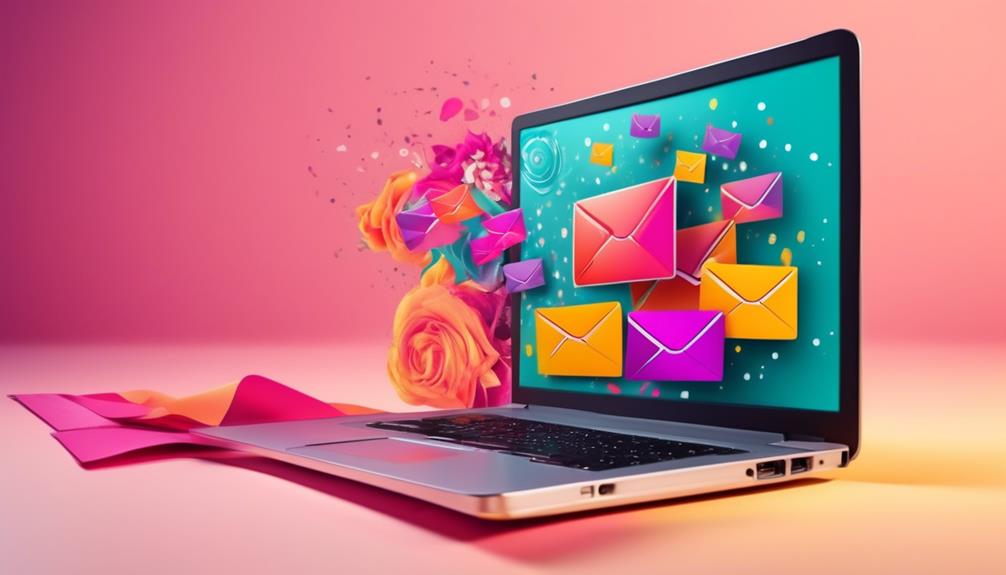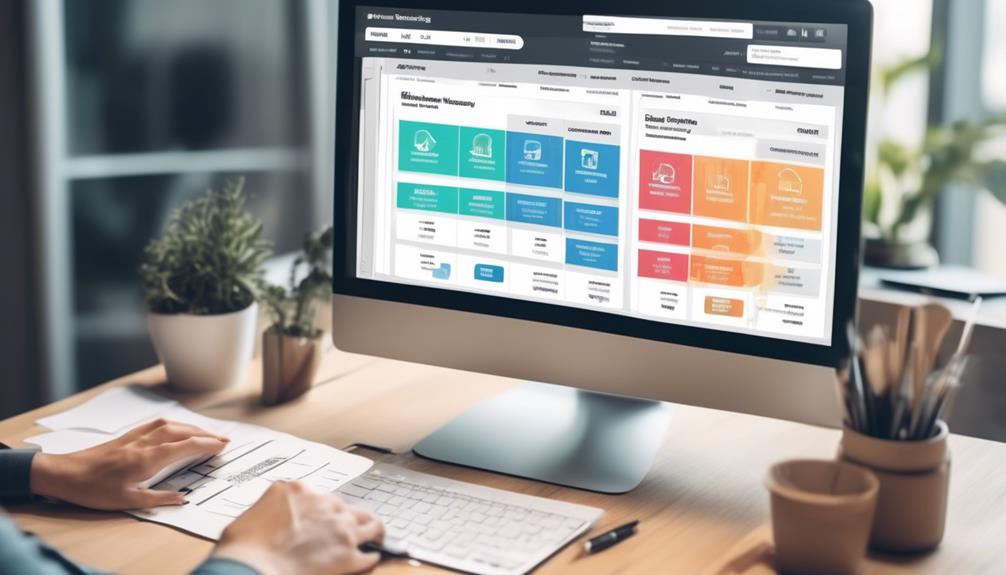Email marketing in the metaverse is a game changer for your brand, blending virtual and augmented realities to create engaging experiences. To succeed, you'll want to focus on personalization and immersive content like videos and 3D graphics. Gamification techniques can greatly boost interaction and participation rates. Don't forget the importance of community engagement to foster brand loyalty. As you navigate this evolving landscape, staying updated on trends and effective strategies will help you connect deeper with your audience. There's a lot more to explore that can set your campaigns apart.
Key Takeaways
- Embrace immersive content like videos and 3D graphics to enhance email engagement in virtual environments.
- Utilize gamification techniques to create interactive email experiences that boost user participation and retention.
- Personalize email campaigns using user behavior data to increase relevance and improve engagement rates.
- Integrate AR/VR visuals in emails to captivate audiences and elevate click-through rates significantly.
- Foster community engagement by hosting virtual events and incorporating user-generated content into email strategies.
Understanding the Metaverse

The metaverse is an exciting frontier where the physical and digital worlds blend seamlessly, allowing you to engage with others through avatars in vibrant, immersive environments. This collective virtual space creates unique opportunities for brands to connect with consumers in real-time, enhancing engagement and fostering brand loyalty through interactive experiences.
Major platforms like Decentraland, Roblox, and Meta are at the forefront of developing technologies that enable these immersive experiences using virtual and augmented reality. With the integration of AI-Powered Virtual Reality in E-Learning, brands can create tailored educational experiences that enchant users and drive deeper connections.
As the metaverse is projected to reach a market value of $800 billion by 2024, it's vital to adapt your digital marketing strategy. By leveraging the immersive nature of the metaverse, you can implement innovative marketing strategies that resonate with users and boost brand awareness.
Imagine creating virtual storefronts or hosting events where consumers can interact with your products in an enthralling way. Integrating AI into your approach will further personalize user experiences, making the metaverse a dynamic space for engagement.
The Role of Email Marketing

In the metaverse, email marketing isn't just about sending messages; it's about creating engaging virtual experiences that captivate users.
To ignite creativity and develop these experiences, marketers should leverage the importance of nurturing an imaginative mindset that resonates with their audience.
You can enhance your campaigns by incorporating personalized strategies and multimedia content that resonate with your audience.
As you explore these innovative approaches, you'll find new ways to connect with users in this dynamic digital landscape.
Engaging Virtual Experiences
While exploring the metaverse, you'll likely discover that email marketing can create engaging virtual experiences that captivate users like never before.
By leveraging immersive experiences such as videos and 3D graphics, you can go beyond traditional formats and draw users in more effectively.
Additionally, just as with investing in cryptocurrencies, understanding user engagement trends can help you tailor your approach more effectively risk management strategies.
Here are three key strategies to enhance audience engagement:
- Gamification: Incorporate elements of gamification in your email campaigns to boost interaction. This could mean offering rewards for participation or creating challenges that resonate with the dynamic nature of the metaverse.
- Tailored Email Campaigns: Customize your emails to reflect the unique identities of users, often created through their avatars. This level of personalization helps foster a deeper connection and keeps recipients interested.
- Announcing Virtual Events: Use email to announce upcoming virtual events, creating anticipation through countdowns and exclusive content. This not only drives registration but also keeps your audience engaged and excited.
Personalized Campaign Strategies
Harnessing personalized campaign strategies is vital for maximizing the impact of email marketing in the metaverse. By utilizing user behavior data, you can create customized messaging that resonates with your audience, leading to a remarkable 20% increase in engagement rates compared to traditional methods.
Additionally, incorporating effective email marketing strategies will help you reach your audience more efficiently. Focus on enhancing your virtual presence through immersive content, as studies show that visuals can boost click-through rates by up to 80%.
Incorporating elements of gamification, like rewards or challenges, can further drive user participation. Gamified experiences engage users more effectively, making your emails stand out.
However, don't forget the importance of trust; clear privacy policies and user reviews are essential, especially since 55% of users consider data privacy a major concern in digital marketing.
Target specific user segments based on their avatar behaviors and preferences to greatly improve conversion rates. Personalized emails can generate transaction rates that are six times higher than non-personalized ones.
Integrating Multimedia Content
To truly capture your audience in the metaverse, integrating multimedia content into your email marketing is essential. As users expect immersive experiences in virtual environments, your campaigns should evolve beyond traditional formats.
The rise of AI-powered technologies has reshaped how we approach content creation, enabling more personalized interactions and experiences, which is crucial in today's digital landscape. Here are three key strategies to enhance your email marketing with multimedia content:
- Incorporate Videos and 3D Graphics: Use engaging visuals to draw your audience in. Videos and 3D graphics greatly boost engagement, transforming your emails into enchanting experiences.
- Add Gamification Elements: Interactive quizzes or challenges can increase user participation. Aligning with the gaming culture in the metaverse not only retains interest but also promotes community interaction.
- Showcase User Reviews and Testimonials: Leverage social proof by displaying customer feedback in your emails. This enhances trust and credibility, particularly essential in a platform where data privacy is a concern for 55% of users.
For more insights on the shifting focus towards AI-driven solutions in healthcare, check out AI-driven solutions.
Engaging Campaign Strategies

To truly engage metaverse users, you need to focus on immersive content creation, gamification techniques, and personalized experiences.
Incorporating elements that reflect current trends, such as star appeal in attractiveness, can further enhance user engagement. By incorporating videos and interactive elements, you'll capture their attention and spark interest.
Tailoring your campaigns to resonate with their virtual lifestyle will keep them coming back for more.
Immersive Content Creation
Immersive content creation can transform your email marketing campaigns, making them more engaging for users in the metaverse. By integrating rich, interactive elements, you can captivate your audience and elevate their experiences.
For instance, reflect on how themes of positivity and warmth from uplifting music, like Blue Skies and Lemonade, can be woven into your narratives.
Here are three strategies to evaluate:
- Utilize 3D Graphics and Videos: Incorporating immersive visuals can greatly enhance engagement. Users expect dynamic content, so leverage these elements to make your emails stand out.
- Craft Immersive Narratives: Weave storytelling into your content. This approach can create emotional connections, fostering brand loyalty as users resonate with your story in a virtual environment.
- Customize for User Avatars: Tailor your campaigns to reflect the unique identities and preferences of your users' avatars. This personal touch can improve response rates, making users feel valued and understood.
Gamification Techniques Utilization
Gamifying your email marketing campaigns can considerably boost user engagement in the metaverse. By incorporating gamification techniques, you can create interactive experiences that draw users in and keep them engaged.
Studies show that gamified experiences can increase participation rates by up to 60%. Furthermore, fostering the transformative power of curiosity within your campaigns can spark new ideas and enhance the overall user experience.
Think about including quizzes or challenges within your emails—these elements can elevate your click-through rates from a mere 2-3% to an impressive 8%.
You should also integrate a rewards system, like virtual badges or points redeemable in the metaverse. This not only incentivizes users to participate but also fosters a sense of achievement, driving repeat engagement and enhancing brand loyalty.
Additionally, leveraging immersive storytelling in your gamified campaigns can create emotional connections, leading to a 20% increase in brand recall compared to traditional methods.
Personalized Experience Design
Engaging your audience in the metaverse goes beyond gamification; it requires a personalized experience that speaks directly to their interests and needs.
By leveraging user behavior data, you can craft tailored campaigns that greatly boost engagement rates. High-quality content and effective keyword research are essential components for capturing your audience's attention in this immersive landscape.
Here are three strategies to reflect on:
- Immersive Environments: Incorporate AR/VR visuals and interactive content into your email campaigns. Studies show that these elements can increase click-through rates by up to 30%, capturing your audience's attention effectively.
- User-Generated Content: Including reviews or testimonials enhances personalization and builds trust. With 79% of consumers influenced by user-generated content, integrating this into your campaigns can considerably improve your credibility.
- Segmentation: Clear segmentation of your email lists based on user activity allows you to deliver highly relevant content. This strategy can improve open rates by 14% and click rates by 10%, compared to non-segmented campaigns.
Creative Examples of Campaigns

In the ever-evolving landscape of the metaverse, brands are finding innovative ways to captivate their audiences through creative email marketing campaigns. One effective approach is announcing your brand's entry into the metaverse by showcasing virtual stores or immersive events. Engaging visuals, including videos or animations, can greatly boost visibility and encourage user registration, making your content more interactive and appealing.
As brands explore these new frontiers, they can draw inspiration from top platforms for online earning that leverage user-friendly interfaces and community feedback to enhance their marketing strategies.
Countdown campaigns with unique themes can build anticipation for product launches or virtual events, driving user engagement and participation. Imagine sending out an email that counts down to an exclusive immersive experience, making recipients enthusiastic to join in.
Additionally, leveraging avatars can create a unique revenue stream. By offering exclusive virtual clothing collections for avatars, you enhance your brand presence while appealing to users' desire for personalization.
Collaborations with other brands in the metaverse also present exciting opportunities. These partnerships allow you to experiment with new marketing strategies and share risks, fostering innovative promotional campaigns and cross-promotion opportunities that can reach a broader audience.
Embrace these creative examples to stand out and engage effectively in the metaverse.
Integrating Interactive Elements

Interaction is at the heart of successful email marketing in the metaverse, transforming static messages into dynamic experiences. By integrating interactive elements, you can elevate user engagement and retention, aligning with the immersive expectations of metaverse users.
Here are three effective strategies to contemplate:
- Incorporate Gamification: Use 3D graphics and gamified features within your emails to create engaging experiences that keep users interested and invested.
- Leverage User-Generated Content: Encourage recipients to share their own creations or experiences, fostering a sense of community and trust. This authentic interaction is invaluable in the metaverse.
- Implement Real-Time Engagement Features: Utilize countdown timers and interactive polls to create urgency and boost participation. These elements drive conversion rates by making your emails feel more alive.
Don't forget to add clear calls-to-action that lead to immersive experiences. By guiding users on a journey of exploration, you enhance their overall experience and encourage them to take part in your virtual events.
With interactive elements woven throughout your email campaigns, you'll create an enticing environment that captures attention and fosters loyalty.
Challenges in the Metaverse

As marketers explore the metaverse, they quickly encounter a range of challenges that can complicate their efforts. One major hurdle is limited accessibility; high-speed internet requirements can hinder mass marketing efforts, affecting the reach of your email campaigns.
Furthermore, misinformation about the metaverse can skew consumer perception, leading to skepticism and reduced engagement with your initiatives.
You'll also need to navigate amplified social issues, such as virtual crimes, which can erode brand trust and reputation. This makes careful messaging essential in your email marketing strategies.
Keeping up with evolving customer needs is another challenge; their expectations are constantly changing, so you must adapt your email content to stay relevant.
Additionally, data privacy concerns loom large, with 55% of users viewing them as a significant issue. This complicates your ability to execute targeted email marketing efforts, as you must prioritize user safety while trying to harness digital assets effectively.
Addressing these challenges head-on will be essential for your success in the metaverse, ensuring that your marketing techniques resonate and build lasting relationships with your audience.
Future Trends in Marketing

There's no doubt that the future of marketing in the metaverse is poised for revolutionary changes.
As the metaverse evolves toward a projected market value of $800 billion by 2024, you'll see innovative strategies transforming how brands engage global audiences.
Here are three trends to watch:
- Immersive Advertising: Brands will increasingly utilize interactive ads and gamification to create unforgettable digital brand experiences, making consumers feel more connected to products and services.
- Virtual Commerce: With advancements in technology, expect seamless shopping experiences that allow users to buy products directly within virtual environments, enhancing convenience and engagement.
- Personalized User Experiences: The integration of AI will enable hyper-personalized marketing strategies, adapting in real-time to user preferences and behaviors, thereby fostering deeper connections.
As these trends unfold, you'll need to adapt your metrics and KPIs to accurately measure success in this new landscape.
Embracing these future trends in marketing won't only elevate your brand but also create lasting relationships with consumers in the metaverse.
Building Brand Loyalty

In the metaverse, building brand loyalty hinges on creating immersive experiences that truly resonate with users. As you engage with 22% of Spanish internet users who've already explored this virtual space, it's essential to deliver unique and intriguing interactions.
One effective way to do this is by leveraging customizable avatars and digital assets like NFTs. These elements allow users to express their identities and affiliations with your brand visually, enhancing their emotional connection.
Incorporating gamification into your email marketing campaigns can further increase user interaction and satisfaction. By adding game-like elements, you encourage users to engage more deeply, fostering a stronger loyalty to your brand.
Hosting virtual events and product launches in the metaverse also plays a significant role; these memorable experiences promote ongoing community engagement, solidifying your brand's presence.
Lastly, don't underestimate the power of user-generated content. By integrating personalized offers and showcasing content created by users, you build trust and loyalty among metaverse users who seek immersive and relevant communications.
Focus on these strategies, and watch your brand loyalty flourish in this exciting digital frontier.
Frequently Asked Questions
How Augmented Reality Is Used in Metaverse?
Augmented reality in the metaverse enhances your experience by overlaying digital elements onto the real world. You can interact with virtual try-ons, customize avatars, and engage in immersive environments, making everything more personalized and exciting.
How Can AR and VR Be Used for Marketing?
Imagine stepping into a world where marketing's not just seen but experienced! You can use AR and VR to create jaw-dropping campaigns that engage consumers, boost sales, and transform ordinary shopping into an unforgettable adventure.
What Is the Difference Between Virtual Reality and Augmented Reality and Metaverse?
Virtual reality immerses you in a digital world, while augmented reality enhances your real surroundings with digital elements. The metaverse combines both, creating an interactive space where you can engage with others and experiences simultaneously.
What Is Metaverse Marketing Strategy?
Metaverse marketing strategy's like diving into a digital wonderland! You'll create immersive experiences, leverage unique assets like NFTs, and host virtual events, all while engaging consumers in ways that traditional marketing can only dream about.
Conclusion
As you step into the metaverse, remember that email marketing isn't just about the inbox anymore; it's your gateway to immersive experiences. Like Alice tumbling down the rabbit hole, you'll uncover endless possibilities for engagement. Embrace creativity and interactivity in your campaigns, and don't shy away from the challenges ahead. By doing so, you'll build lasting connections and brand loyalty in this brave new world, ensuring your marketing efforts resonate in both reality and virtual domains.









